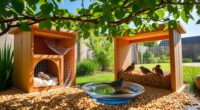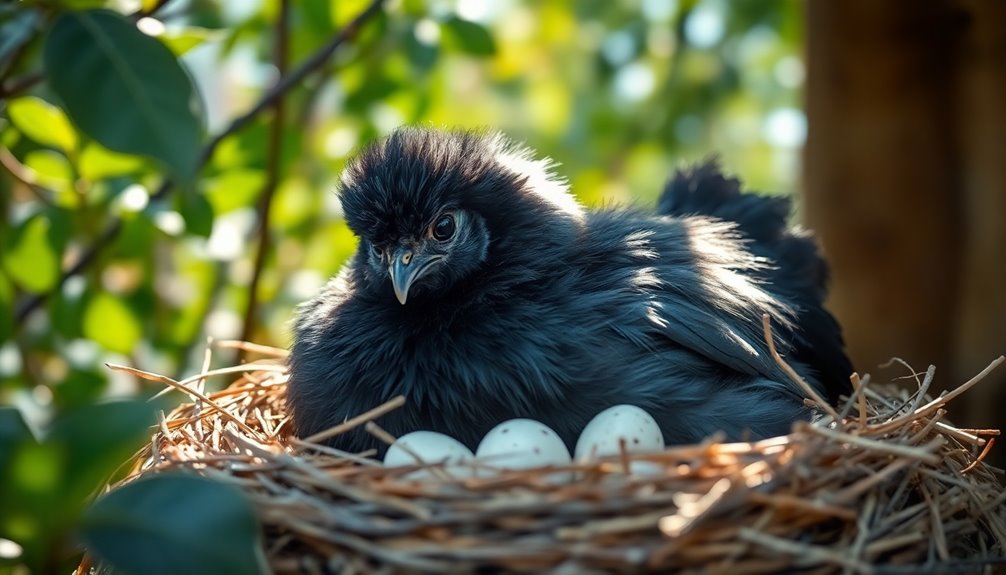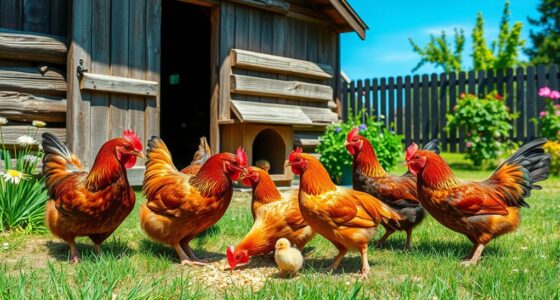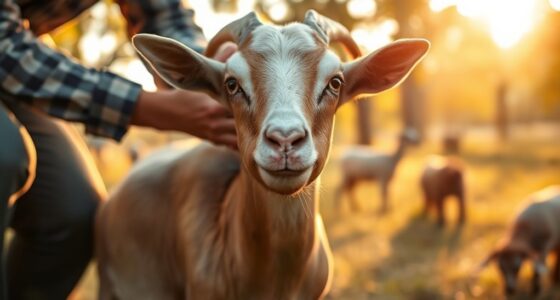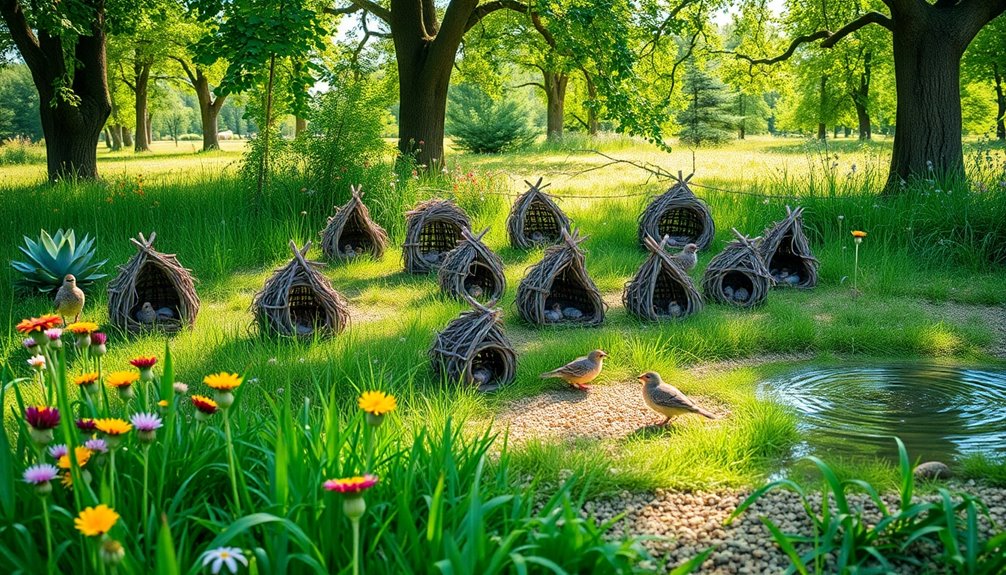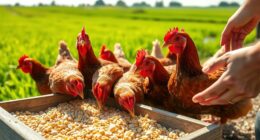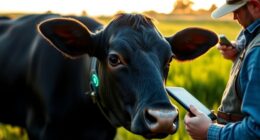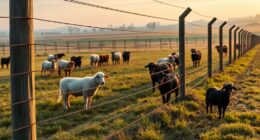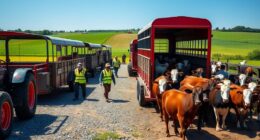Roosters start crowing 1 to 2 hours before sunrise, acting like nature's alarm clock. Their internal clocks align with the Earth's 24-hour cycle, peaking at dawn. Crowing is influenced by social hierarchy, where the dominant rooster leads the call. Environmental triggers, like light exposure, can prompt them to crow even at night. This vocal behavior serves to mark territory and communicate dominance. There's much more to learn about their fascinating crowing patterns and social dynamics.
Key Takeaways
- Roosters typically start crowing 1 to 2 hours before sunrise, marking the beginning of their daily vocalizations.
- The dominant rooster leads the crowing, with subordinate roosters following in a strict social hierarchy.
- Crowing is triggered by light exposure, with increased vocalizations occurring during longer daylight hours.
- Environmental changes, such as storms or sounds from other roosters, can prompt unexpected crowing at various times.
- Internal circadian rhythms regulate the timing of crowing, peaking at dawn due to synchronization with the Earth's 24-hour cycle.
The Timing of Morning Crowing
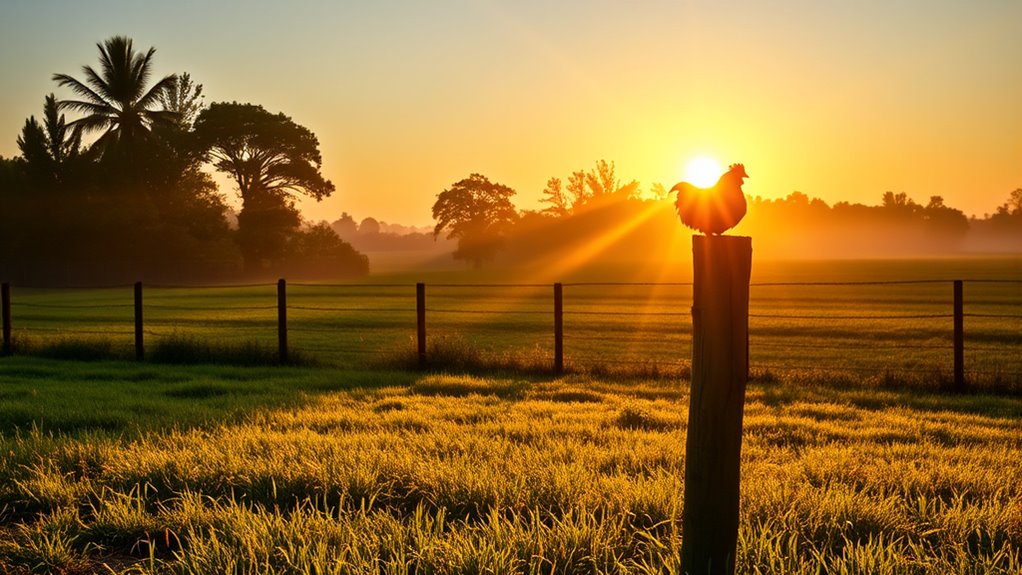
As dawn approaches, you might notice that roosters begin to crow about 1 to 2 hours before sunrise. This early crowing is led by the highest-ranking rooster, who sets the tone for the others in the flock.
The subordinates follow in a consistent order, showcasing their social hierarchy. Changes in light, whether natural or artificial, trigger this behavior, highlighting their sensitivity to environmental cues.
Subordinate roosters adhere to a strict order, demonstrating their social hierarchy influenced by light changes.
Interestingly, roosters can anticipate dawn, adapting their crowing even in controlled lighting. While the timing may vary a bit each day, the established order of crowing remains steadfast.
This morning ritual not only communicates dominance but also marks territory, making it an essential part of a rooster's daily routine.
Internal Circadian Rhythms
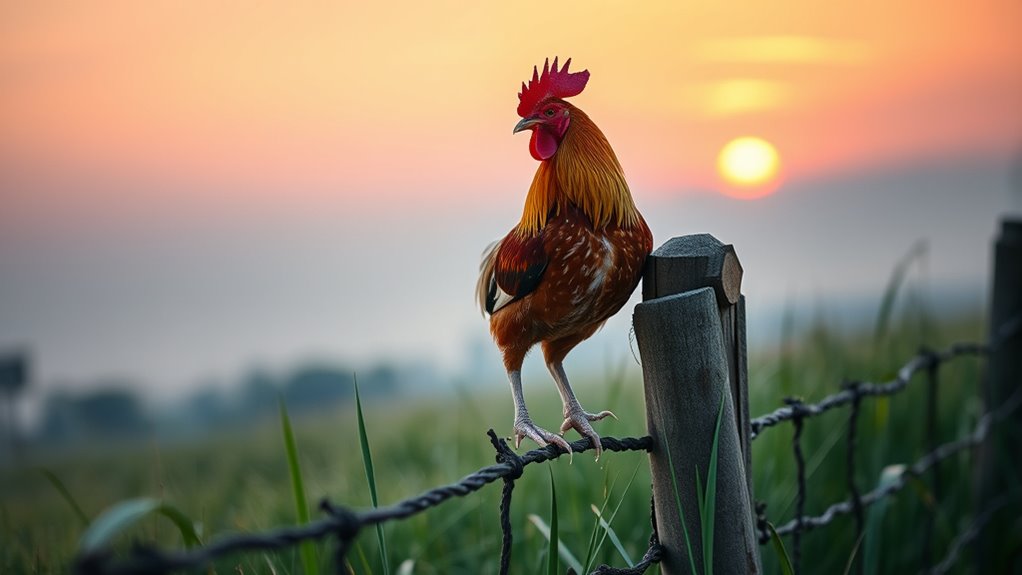
Roosters' crowing isn't just a response to the rising sun; it's deeply rooted in their internal circadian rhythms. These natural rhythms synchronize with the Earth's 24-hour cycle, allowing roosters to crow even in darkness.
You might notice that their crowing peaks at dawn, demonstrating a powerful internal clock. Though external stimuli, like light flashes or other roosters' calls, can trigger crowing, they're most effective around dawn.
Continuous twilight can weaken this rhythm, leading to irregular crowing patterns. Essentially, roosters possess a biological clock that governs their vocalizations, making them a fascinating model for studying genetically controlled behaviors in animals.
Understanding their internal rhythms sheds light on the broader mechanisms of animal behavior.
The Role of Social Hierarchy
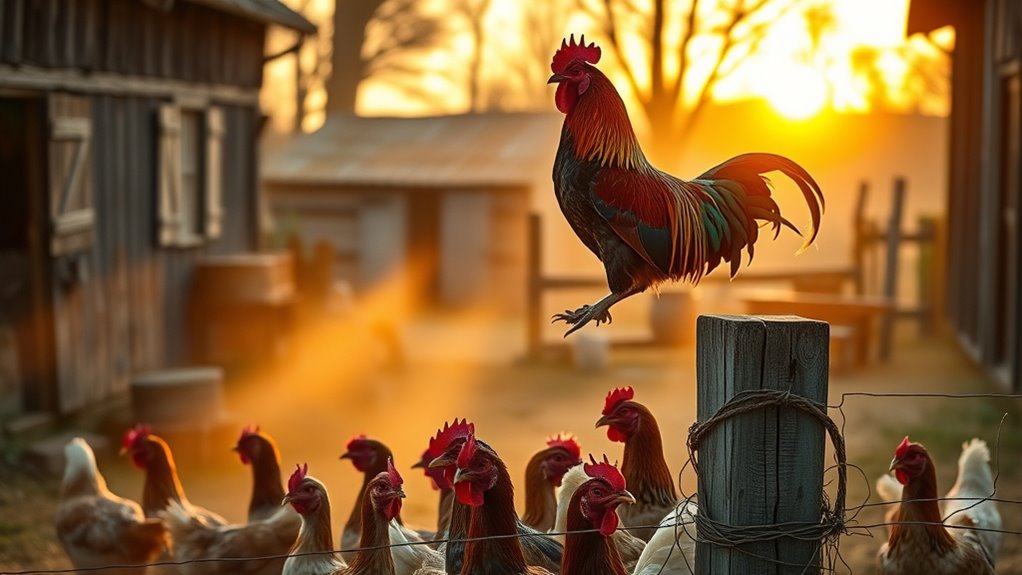
While you might think crowing is solely tied to the time of day, social hierarchy plays a significant role in when and how often roosters vocalize. The dominant rooster sets the timing for predawn crowing, with subordinate roosters waiting to follow in order of rank.
This pecking order influences everything from resource access to social behavior. When the top rooster is removed, the next in line quickly takes over, ensuring continuity in crowing patterns.
Crowing acts as a social cue, reinforcing territorial boundaries and group cohesion. Subordinate roosters often suppress their internal clocks, aligning their vocalizations with the dominant bird.
This strict hierarchy maintains stability, allowing each rooster to know its place within the group dynamics.
Environmental Triggers
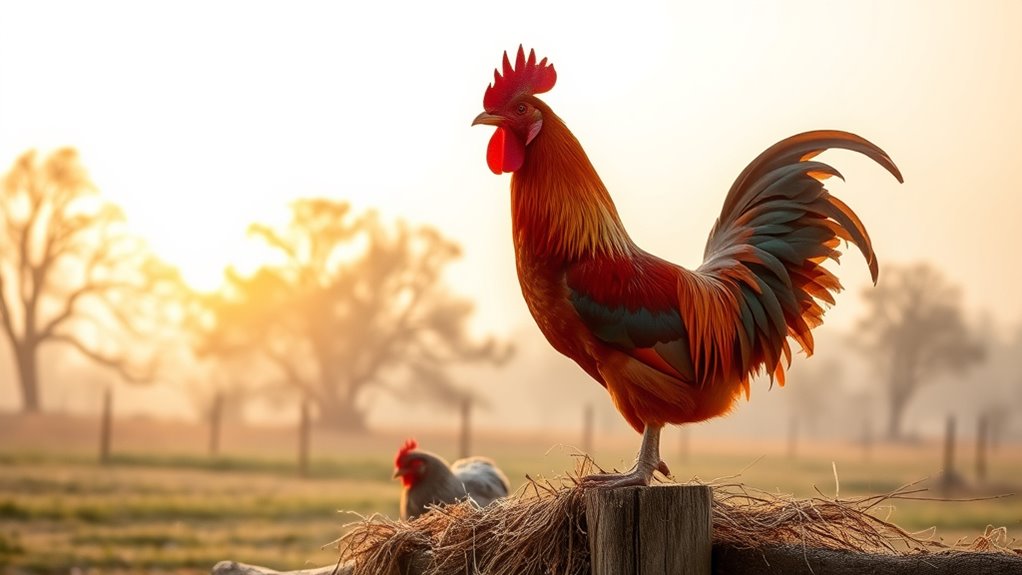
Crowing isn't just about hierarchy; environmental factors significantly influence when and how often roosters vocalize.
Light exposure, both natural and artificial, is a key trigger, prompting them to crow at dawn or even during the night with sudden illumination.
You might notice that the sound of other roosters can also set off a chain reaction, encouraging nearby roosters to join in.
Environmental changes, like brewing storms, can elevate their vocalizations, while various noises—like car sounds or door movements—can prompt unexpected crowing.
Seasonal variations play a role too; longer daylight hours typically increase crowing frequency, while extreme weather can cause them to conserve energy and crow less.
All these triggers showcase the roosters' sensitivity to their environment.
Biological Mechanisms Behind Crowing
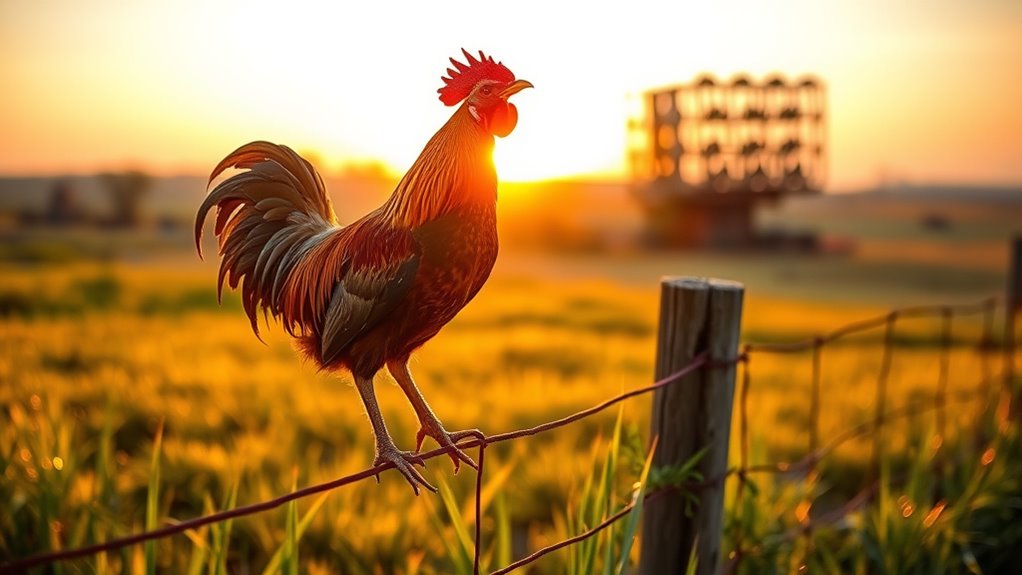
Understanding the biological mechanisms behind crowing reveals the intricate interplay of hormones, genetics, and brain functions.
Roosters possess an internal circadian clock, prompting them to crow, often before dawn. Testosterone plays a vital role in activating genes related to crowing, particularly the cholecystokinin B receptor (CCKBR).
When cholecystokinin binds to CCKBR receptors in the nucleus intercollicularis (ICo), it triggers the crowing response. This receptor's expression relies on androgen levels, which are typically higher in roosters than hens.
Additionally, specific brain circuits and neurotransmitters, including CCK, are critical in regulating this vocal behavior. Overall, these biological factors work harmoniously, ensuring roosters initiate their distinctive calls at the right time.
Territorial and Communication Functions
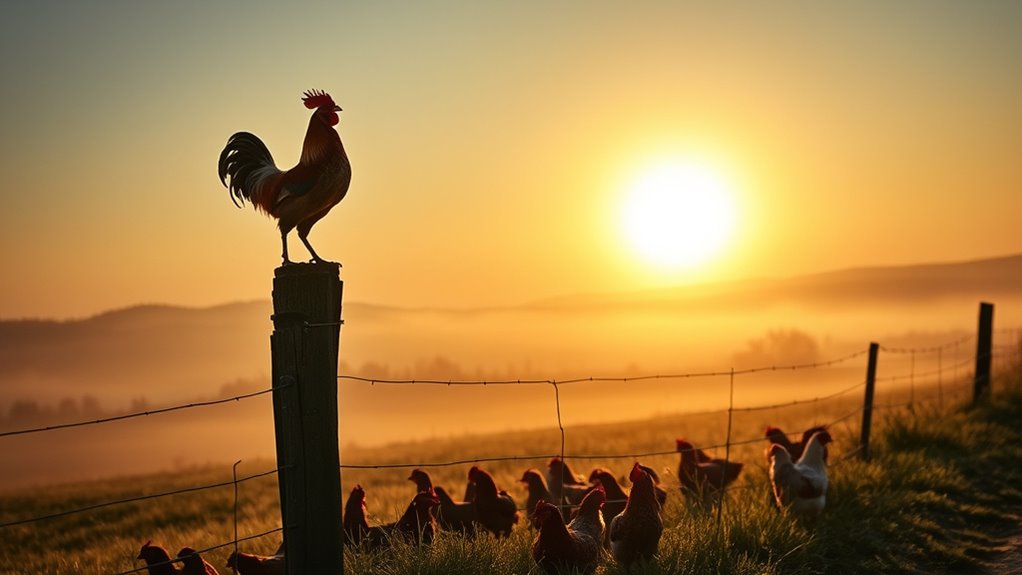
Roosters utilize their crowing as a crucial tool for establishing territory and facilitating communication within their social structures. By crowing, they proclaim their territory, warning other roosters to stay away and signaling their presence to potential predators. This auditory marking helps maintain boundaries and reinforces their social hierarchy, with dominant roosters crowing first.
Additionally, roosters communicate with hens, indicating readiness to mate and asserting dominance over food resources during feeding times. Their crowing patterns respond to external stimuli, ensuring they maintain social interactions and establish connections within and between flocks.
The Impact of Artificial Lighting
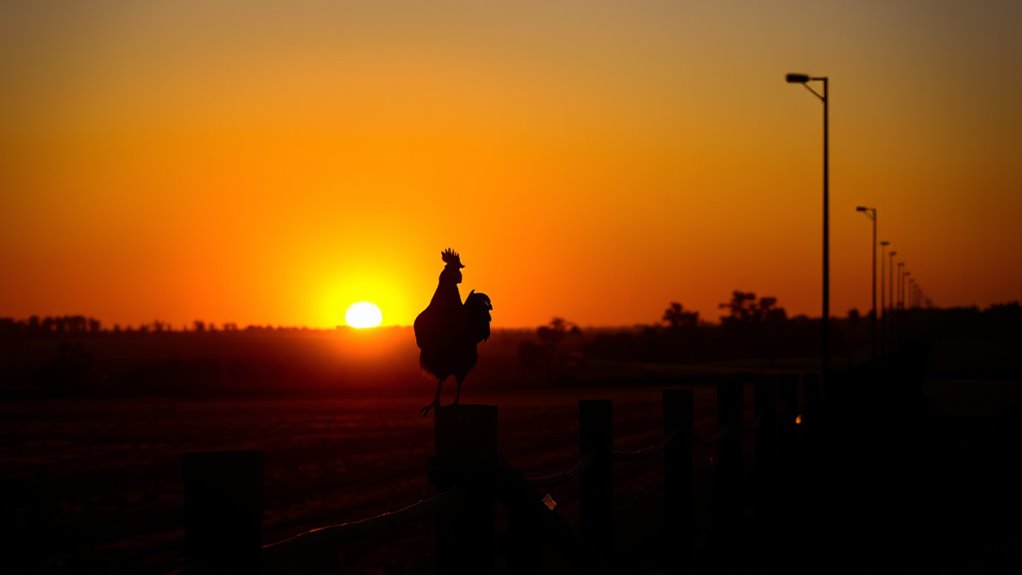
While natural light plays a crucial role in regulating a rooster's crowing patterns, artificial lighting can significantly alter these behaviors. Your rooster primarily relies on its internal circadian rhythm, but artificial light can trigger crowing at odd hours, especially near dawn.
When exposed to constant dim light, their natural crowing cycle may eventually become desynchronized. You might notice that even in artificial settings, crowing peaks in the early morning.
Roosters remain sensitive to external stimuli, such as light flashes or other roosters crowing, which can prompt them to crow. Additionally, social hierarchy influences the order of crowing, with the dominant rooster leading, regardless of the lighting conditions.
Crowing Patterns in Different Seasons
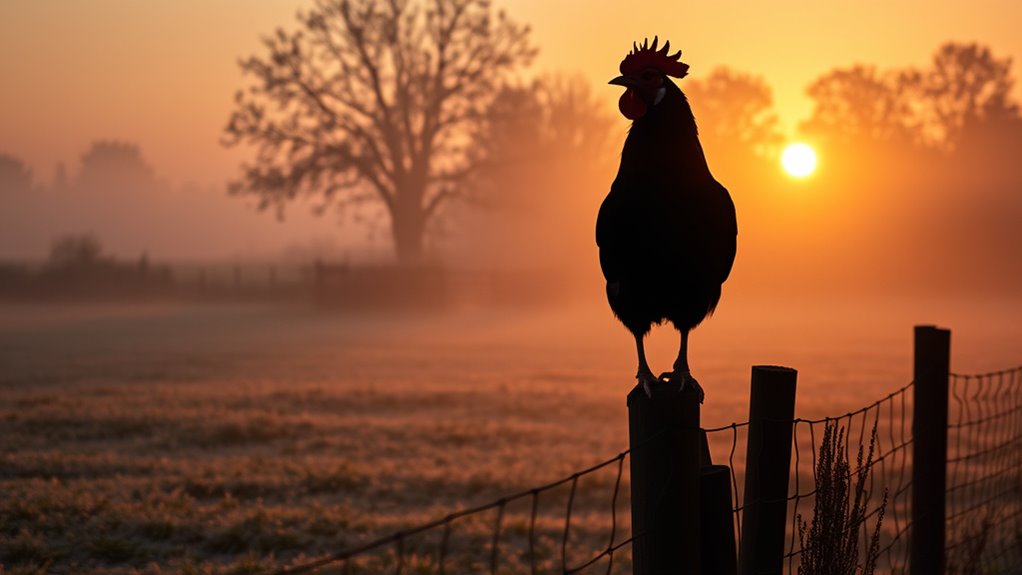
As the seasons change, you'll notice that your rooster's crowing patterns shift dramatically.
In spring, longer daylight hours trigger more frequent crowing as roosters become vocal to attract hens during the breeding season.
However, during extreme heat or cold, you might find your rooster crowing less often due to environmental stress.
The social hierarchy also plays a role; higher-ranking roosters tend to crow more, asserting their dominance regardless of the season.
In contrast, during summer, you may hear a chorus of crowing if multiple roosters are around, creating a round-robin effect.
Pay attention to these seasonal changes, as they reflect both natural rhythms and your rooster's social dynamics!
Experimental Findings on Crowing Behavior
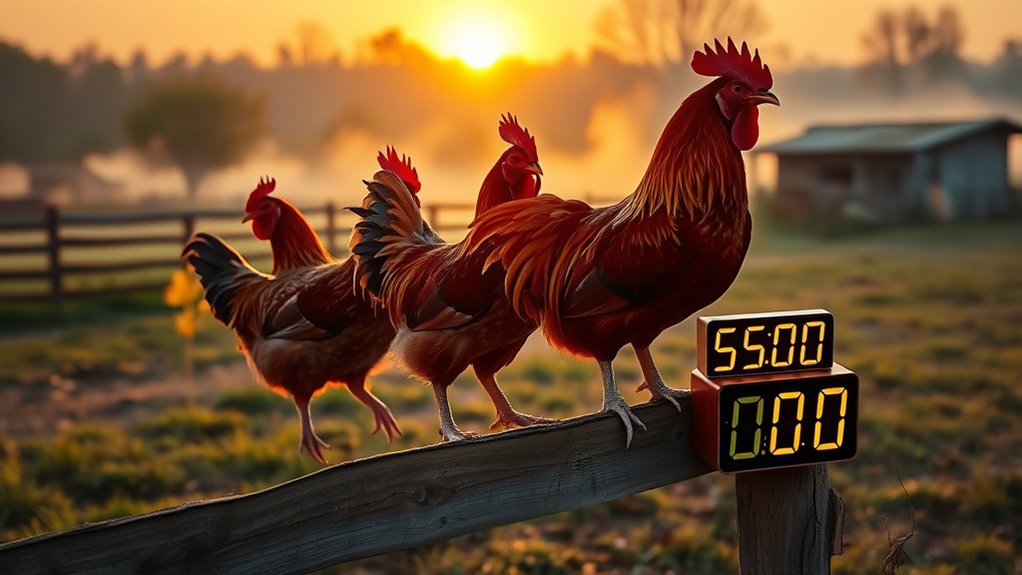
Understanding the experimental findings on crowing behavior reveals fascinating insights into how roosters interact with their environment and each other.
Roosters possess an internal circadian clock that drives their crowing, ensuring they announce dawn consistently, even in darkness. This clock operates independently of external light, highlighting its biological significance.
Social hierarchy also influences crowing; the dominant rooster crows first, while subordinates follow in order. External stimuli, like sudden noises, may trigger crowing, but morning remains the peak time.
Anatomically, roosters are equipped to produce distinct sounds, using their vocal apparatus effectively.
Frequently Asked Questions
Do All Roosters Crow at the Same Time?
No, not all roosters crow at the same time. Their crowing depends on factors like social rank and individual biological clocks.
You'll notice that dominant roosters usually crow first, setting the tone for the others. Environmental cues also play a role, so if you've got different roosters together, you might hear varying crowing patterns.
Each rooster adapts its schedule based on its unique circumstances, leading to a delightful cacophony throughout the day.
Can Hens Crow Like Roosters?
Yes, hens can crow like roosters, though it's less common.
If you've got a flock without a rooster, some hens might start crowing to assert dominance. Certain breeds, like Sebrights, are more likely to display this behavior.
You might notice this more in aging hens due to hormonal changes. While their crowing isn't as loud or frequent, it's a fascinating aspect of chicken behavior you might find intriguing!
How Long Can a Rooster Crow Continuously?
Roosters can crow for varying lengths of time, but they typically don't crow continuously without breaks.
You'll notice they crow in intervals, responding to environmental stimuli or asserting their dominance. They might crow for a few seconds at a time, followed by rest periods.
Factors like their health, age, and social interactions with other roosters can also influence how long and how often they crow throughout the day.
What Factors Influence a Rooster's Crowing Volume?
When you hear a rooster crow, it can be a gentle morning greeting or a loud wake-up call. Several factors influence this volume.
Different breeds produce varying loudness levels, while environmental elements like light and noise can amplify their calls.
Health and age also play a role; younger, healthier roosters tend to crow louder.
Social dynamics within their flock can affect frequency, too, with dominant roosters often crowing more boldly.
Do Different Rooster Breeds Have Unique Crowing Patterns?
Yes, different rooster breeds definitely have unique crowing patterns. When you observe them, you'll notice variations in pitch and tone.
For instance, Sussex roosters often have a melodious crow, while Bantams produce higher-pitched sounds. Larger breeds like Cochins tend to have deeper crows.
These distinct characteristics can influence your choice if you're considering adding roosters to your flock. It's fascinating how breed traits shape their vocalizations and communication styles!
Conclusion
In conclusion, roosters typically start crowing around 4 to 5 a.m., but their timing can shift based on various factors. Interestingly, studies show that roosters can crow over 20 times in just one hour during peak times. This impressive vocalization isn't just for show; it plays a key role in their social structure and territory. Understanding these patterns not only sheds light on their behavior but also highlights the intricate relationship between animals and their environment.


